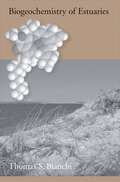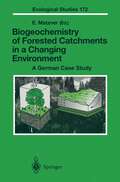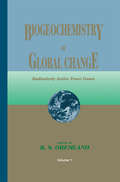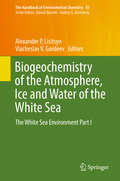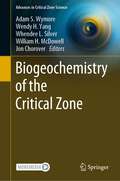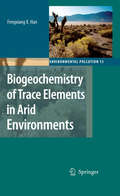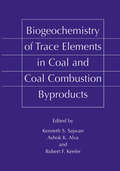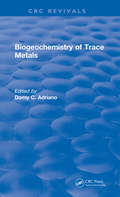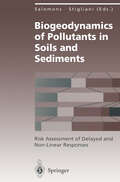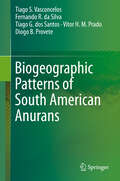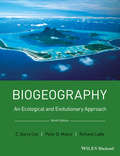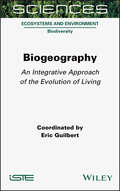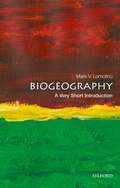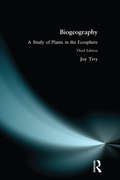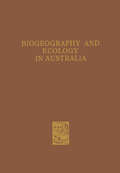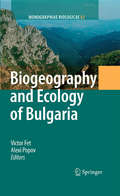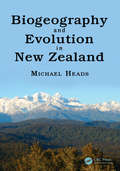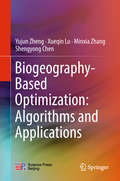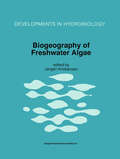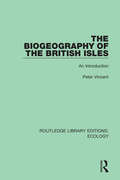- Table View
- List View
Biogeochemistry of Estuaries
by Thomas S. BianchiBiogeochemistry of Estuaries offers a comprehensive and interdisciplinary approach to understanding biogeochemical cycling in estuaries. Designed as a text for intermediate to advanced students, this book utilizes numerous illustrations and an extensive literature base to impart the current state-of-the-art knowledge in this field. While many of the existing books in estuarine science are comprised of edited volumes, typically focused on highly specific topics in estuaries,Biogeochemistry of Estuaries provides, for the first time, a unique foundation in the areas of geomorphology, geochemistry, biochemistry, aqueous chemistry, and ecology, while making strong linkages (trhoughout the text) to ecosystem-based processes in estuarine sciences. Estuaries, located at the interface between land and the coastal ocean are dynamic, highly productive systems that, in many cases, have been historically associated with development of many of the great centers of early human civilization. Consequentially, these systems have and continue to be highly impacted by anthropogenic inputs. This timely book takes the foundational basis of elemental cycling in estuarine and applies it to estuarine management issues. Biogeochemistry of Estuaries will be welcomed by estuarine/marine scientists, ecologists, biogeochemists, and environmentalists around the world.
Biogeochemistry of Forested Catchments in a Changing Environment: A German Case Study (Ecological Studies #172)
by Egbert MatznerForest ecosystems represent a major type ofland use in Germanyand in Europe. They provide a number of functions, or ecosystem services, beneficial to humans, namely biomass production, regulation of the water- and energy cyde, C and N sequestration, erosion control, recreation, and they act as habitat for numerous species. The stability of forest ecosystems in Europe as influenced by the deposition of air pollutants has been a matter of debate for more than 20 years. Besides atmospheric deposition, other environmental conditions affecting forest ecosystems, such as temperature, CO content of the atmosphere 2 and precipitation, have significantly changed in the past and continue to change in the future. Quantifying and predicting the effects of these changes on ecosys tem functioning are achallenge to ecosystem research and also a requirement to establish sustainable use of forest ecosystems in the future. This book summarizes results of long-term, interdisciplinary ecosystem research conducted in two forested catchments and coordinated at the Bayreuth Institute of Terrestrial Ecosystem Research (BITÖK), University of Bayreuth, Germany. It does not aim to summarize all the research of BITÖ K in the past decade, which would go far beyond the studies in these two catch ments. Instead, we concentrate here on the long-term developments in the biogeochemistry of carbon and mineral elements and on the water cyde, at both the plot and the catchment scale.
Biogeochemistry of Global Change: Radiatively Active Trace Gases Selected Papers from the Tenth International Symposium on Environmental Biogeochemistry, San Francisco, August 19–24, 1991
by Ronald S. OremlandCertain trace gases in the atmosphere are able to absorb electromagnetic energy from the reflection of solar radiation from the Earth's surface. These gases have been increasing steadily and there is concern that they will change global climatic conditions by warming the atmosphere--the so-called ``greenhouse effect.'' Many of these gases originate from biological systems. The Biogeochemistry of Global Change discusses the role of radiative trace gases in this process. The disciplines covered in the book include microbiology, geochemistry, atmospheric chemistry, plant physiology, oceanography and limnology, and soil science. This diversity allows for cross-fertilization, achieving a better understanding of the complex mechanisms for biological and chemical formation, the destruction of trace gases, and the manipulation of ecosystems. Some of the topics covered include: biological mechanisms of formation and destruction of various ``greenhouse'' gases (such as methane, nitrous oxide, carbon dioxide, dimethylsulfide, and chlorofluorocarbons); the outward and consumptive flux of trace gases from marine and terrestrial systems (including anthropogenic sources); global trace gas modeling studies; the atmospheric physical and chemical reactions of trace gases; and the environmental significance of various trace gases in ancient and current atmospheres. The Biogeochemistry of Global Change provides both reviews and primary source material for active researchers in this field and for microbiologists and atmospheric chemists.
Biogeochemistry of the Atmosphere, Ice and Water of the White Sea: The White Sea Environment Part I (The Handbook of Environmental Chemistry #81)
by Alexander P. Lisitsyn Viacheslav V. GordeevThis book is devoted to the biogeochemical environment of the White Sea, an inland sea in the Northwestern region of Russia. It provides a comprehensive review and discusses the latest research findings on the oceanology, sedimentology and biogeochemistry of the White Sea water column. The topics discussed include the regulation of the physico-geographical conditions in the White Sea basin; dispersed sedimentary substance of the atmosphere and the cryosphere; the geochemical peculiarities of the river discharge into the White Sea; and the phyto- and zooplankton activities in the White Sea. Taking the biggest river in the White Sea basin as an example, the authors closely examine the deposition of suspended particulate matter, the biogeochemical behaviour of dissolved and suspended forms of organic material and the significant group of chemical elements in the river-sea mixing zone of the Severnaya Dvina River. The book ends with a summary of the key conclusions and recommendations. Together with the companion volume Sedimentation Processes in the White Sea: The White Sea Environment Part II, it offers an essential source of information for postgraduate students, researchers and stakeholders alike.
Biogeochemistry of the Critical Zone (Advances in Critical Zone Science)
by Adam S. Wymore Wendy H. Yang Whendee L. Silver William H. McDowell Jon ChoroverThis book highlights recent advances in the discipline of biogeochemistry that have directly resulted from the development of critical zone (CZ) science. The earth's critical zone (CZ) is defined from the weathering front and lowest extent of freely circulating groundwater up through the regolith and to the top of the vegetative canopy. The structure and function of the CZ is shaped through tectonic, lithologic, hydrologic, climatic, and biological processes and is the result of processes occurring at multiple time scales from eons to seconds. The CZ is an open system in which energy and matter are both transported and transformed. Critical zone science provides a novel and unifying framework to consider those coupled interactions that control biogeochemical cycles and fluxes of energy and matter that are critical to sustaining a habitable planet. Biogeochemical processes are at the heart of energy and matter fluxes through ecosystems and watersheds. They control the quantity and quality of carbon and nutrients available for living organisms, control the retention and export of nutrients affecting water quality and soil fertility, and influence the ability for ecosystems to sequester carbon. As the term implies, biogeochemical cycles, and the rates at which they occur, result from the interaction of biological, chemical, and physical processes. However, finding a unifying framework by which to study these interactions is challenging, and the different components of bio-geo-chemistry are often studied in isolation. The authors provide both reviews and original research contributions with the requirement that the chapters incorporate a CZ framework to test biogeochemical theory and/or develop new and robust predictive models regarding elemental cycles. The book demonstrates how the CZ framework provides novel insights into biogeochemistry.
Biogeochemistry of Trace Elements in Arid Environments (Environmental Pollution #13)
by Fengxiang X. HanThis book offers comprehensive coverage of trace elements in arid zone regions. It begins by introducing the nature and properties of arid zone soil, followed by coverage of the major aspects of the trace elements and heavy metals of most concern in the world’s arid and semi-arid soils. A comprehensive, focused case study on transfer fluxes of trace elements in Israeli arid soils is used to illustrate the themes presented in the book.
Biogeochemistry of Trace Elements in Coal and Coal Combustion Byproducts
by Robert F. Keefer Ashok K. Alva Kenneth S. SajwanThe research papers in this book present current knowledge of the sources, pathways, behavior, and effects of trace elements in soils, waters, plants, and animals. It is of interest to a variety of readers, including public health and environmental professionals, consultants, and academicians.
Biogeochemistry of Trace Metals: Advances In Trace Substances Research (CRC Press Revivals)
by Domy C. AdrianoBiogeochemistry of Trace Metals is a compendium of the most recent information available on the effects of trace metals in soil quality and its potential threat on the transfer of these contaminants to consumers. Most of the chapters in the book were presented as papers during the First International Conference on the Biogeochemistry of Trace Elements (formerly Metals in Soils, Plants, Waters, and Animals) held in Orlando, Florida in May, 1990. Topics discussed include background levels of metals in soils and/or plants (covering western Europe; temperate, humid Europe; and the People's Republic of China); metal cycling and transfer in the food chain in agroecosystems; uptake and accumulation of metals by bacteria, fungi, and invertebrates; mechanistic aspects of metals; the microbial aspects of soil selenium losses; and manganese sorption on soil constituents.
Biogeochemistry of Trace Metals: Advances In Trace Substances Research (CRC Press Revivals)
by Domy C. AdrianoBiogeochemistry of Trace Metals is a compendium of the most recent information available on the effects of trace metals in soil quality and its potential threat on the transfer of these contaminants to consumers. Most of the chapters in the book were presented as papers during the First International Conference on the Biogeochemistry of Trace Elements (formerly Metals in Soils, Plants, Waters, and Animals) held in Orlando, Florida in May, 1990. Topics discussed include background levels of metals in soils and/or plants (covering western Europe; temperate, humid Europe; and the People's Republic of China); metal cycling and transfer in the food chain in agroecosystems; uptake and accumulation of metals by bacteria, fungi, and invertebrates; mechanistic aspects of metals; the microbial aspects of soil selenium losses; and manganese sorption on soil constituents.
Biogeodynamics of Pollutants in Soils and Sediments: Risk Assessment of Delayed and Non-Linear Responses (Environmental Science and Engineering)
by William M. Stigliani WimSalomonsIn the USA, Western and Central Europe, there are many large-scale polluted sites that are too large to be cleaned up economically with available technologies. The pollution is caused by heavy industries to soils and sediments in waterways and reservoirs. Since these areas are expected to remain polluted for many years, it is necessary to take a long-term view to insure that the capacity to retain the contaminants is not diminished and to understand the potential for large-scale contaminant mobilization at these sites triggered by changing environmental conditions. This book provides information for predicting long-term changes and making risk assessments and describes the approach of geochemical engineering to handling large-scale polluted sites.
Biogeographic Patterns of South American Anurans
by Tiago S. Vasconcelos Fernando R. da Silva Tiago G. dos Santos Vitor H. Prado Diogo B. ProveteThis book analyzes different facets of anuran amphibian distribution in South America. We integrate alternative biological metrics employing cutting-edge methods to understand the dynamic processes underlying species distribution patterns. By using the modern biogeographic toolbox, we explore how richness gradients, phylogenetic diversity, functional diversity, and range size/endemism distribution of amphibians vary along the continent. Moreover, we present a robust proposal for priority areas for conservation of anurans in South America that maximizes representativeness of distinct biodiversity facets.
Biogeography: An Ecological and Evolutionary Approach
by C. Barry Cox Peter D. Moore Richard LadleThrough eight successful editions, and over nearly 40 years, Biogeography: An Ecological and Evolutionary Approach has provided a thorough and comprehensive exploration of the varied scientific disciplines and research that are essential to understanding the subject. The text has been praised for its solid background in historical biogeography and basic biology, that is enhanced and illuminated by discussions of current research. This new edition incorporates the exciting changes of the recent years, and presents a thoughtful exploration of the research and controversies that have transformed our understanding of the biogeography of the world. It also clearly identifies the three quite different arenas of biogeographical research: continental biogeography, island biogeography and marine biogeography. It is the only current textbook with full coverage of marine biogeography. It reveals how the patterns of life that we see today have been created by the two great Engines of the Planet - the Geological Engine, plate tectonics, which alters the conditions of life on the planet, and the Biological Engine, evolution, which responds to these changes by creating new forms and patterns of life.
Biogeography: An Ecological and Evolutionary Approach
by C. Barry Cox Peter D. Moore Richard LadleThrough eight successful editions, and over nearly 40 years, Biogeography: An Ecological and Evolutionary Approach has provided a thorough and comprehensive exploration of the varied scientific disciplines and research that are essential to understanding the subject. The text has been praised for its solid background in historical biogeography and basic biology, that is enhanced and illuminated by discussions of current research. This new edition incorporates the exciting changes of the recent years, and presents a thoughtful exploration of the research and controversies that have transformed our understanding of the biogeography of the world. It also clearly identifies the three quite different arenas of biogeographical research: continental biogeography, island biogeography and marine biogeography. It is the only current textbook with full coverage of marine biogeography. It reveals how the patterns of life that we see today have been created by the two great Engines of the Planet - the Geological Engine, plate tectonics, which alters the conditions of life on the planet, and the Biological Engine, evolution, which responds to these changes by creating new forms and patterns of life.
Biogeography: An Integrative Approach of the Evolution of Living
by Eric GuilbertThe recent progress in analytical methods, aided by bringing in a wide range of other disciplines, opens up the study to a broader field, which means that biogeography now goes far beyond a simple description of the distribution of living species on Earth.Originating with Alexander von Humboldt, biogeography is a discipline in which ecologists and evolutionists aim to understand the way that living species are organized in connection with their environments. Today, as we face major challenges such as global warming, massive species extinction and devastating pandemics, biogeography offers hypotheses and explanations that may help to provide solutions.This book presents as wide an overview as possible of the different fields that biogeography interacts with. Sixteen authors from all over the world offer different approaches based on their specific areas of knowledge and experience; thus, we intend to illustrate the vast number of diverse aspects covered by biogeography.
Biogeography: An Integrative Approach of the Evolution of Living
by Eric GuilbertThe recent progress in analytical methods, aided by bringing in a wide range of other disciplines, opens up the study to a broader field, which means that biogeography now goes far beyond a simple description of the distribution of living species on Earth.Originating with Alexander von Humboldt, biogeography is a discipline in which ecologists and evolutionists aim to understand the way that living species are organized in connection with their environments. Today, as we face major challenges such as global warming, massive species extinction and devastating pandemics, biogeography offers hypotheses and explanations that may help to provide solutions.This book presents as wide an overview as possible of the different fields that biogeography interacts with. Sixteen authors from all over the world offer different approaches based on their specific areas of knowledge and experience; thus, we intend to illustrate the vast number of diverse aspects covered by biogeography.
Biogeography: Classic Papers With Commentaries (Very Short Introductions)
by Mark V. LomolinoBiogeography is the study of geographic variation in all characteristics of life - ranging from genetic, morphological and behavioural variation among regional populations of a species, to geographic trends in diversity of entire communities across our planet's sufrace. From the ancient hunters and gatherers to the earliest naturalists, Charles Darwin, Alfred Russel Wallace, and scientists today, the search for patterns in life has provided insights that proved invaluable for understanding the natural world. And many, if not most, of the compelling kaleidoscope of patterns in biological diversity make little sense unless placed in an explicit geographic context. The Very Short Introduction explains the historical development of the field of biogeography, its fundamental tenets, principles and tools, and the invaluable insights it provides for understanding the diversity of life in the natural world. As Mark Lomolino shows, key questions such as where species occur, how they vary from place to place, where their ancestors occurred, and how they spread across the globe, are essential for us to develop effective strategies for conserving the great menagerie of life across our planet. ABOUT THE SERIES: The Very Short Introductions series from Oxford University Press contains hundreds of titles in almost every subject area. These pocket-sized books are the perfect way to get ahead in a new subject quickly. Our expert authors combine facts, analysis, perspective, new ideas, and enthusiasm to make interesting and challenging topics highly readable.
Biogeography: A Study of Plants in the Ecosphere
by Joy TivyThe third edition of this classic text, presents a broad-based study of the variations in the form and functioning of the biosphere at regional and global scale.
Biogeography: A Study of Plants in the Ecosphere
by Joy TivyThe third edition of this classic text, presents a broad-based study of the variations in the form and functioning of the biosphere at regional and global scale.
Biogeography and Ecology of Bulgaria (Monographiae Biologicae #82)
by Victor Fet Alexi PopovFrom single-celled organisms in Black Sea sand to endemic cave crustaceans, from mountain glacial relict insects to the most diverse bird fauna in Europe, the fauna of Bulgaria has been a subject of study for more than a century. This is the first English language survey of all vertebrate and many key invertebrate groups of Bulgaria, their faunistics, origin, geographical and ecological distribution, and conservation issues.
Biogeography and Evolution in New Zealand (CRC Biogeography Series)
by Michael HeadsBiogeography and Evolution in New Zealand provides the first in-depth treatment of the biogeography of New Zealand, a region that has been a place of long-enduring interest to ecologists, evolutionary scientists, geographers, geologists, and scientists in related disciplines. It serves as a key addition to the contemporary discussion on regionalization—how is New Zealand different from the rest of the world? With what other areas does it share its geology, history, and biota? Do new molecular phylogenies show that New Zealand may be seen as a biological ‘parallel universe’ within global evolution?
Biogeography and Evolution in New Zealand (CRC Biogeography Series #1)
by Michael HeadsBiogeography and Evolution in New Zealand provides the first in-depth treatment of the biogeography of New Zealand, a region that has been a place of long-enduring interest to ecologists, evolutionary scientists, geographers, geologists, and scientists in related disciplines. It serves as a key addition to the contemporary discussion on regionalization—how is New Zealand different from the rest of the world? With what other areas does it share its geology, history, and biota? Do new molecular phylogenies show that New Zealand may be seen as a biological ‘parallel universe’ within global evolution?
Biogeography-Based Optimization: Algorithms and Applications
by Yujun Zheng Xueqin Lu Minxia Zhang Shengyong ChenThis book introduces readers to the background, general framework, main operators, and other basic characteristics of biogeography-based optimization (BBO), which is an emerging branch of bio-inspired computation. In particular, the book presents the authors’ recent work on improved variants of BBO, hybridization of BBO with other algorithms, and the application of BBO to a variety of domains including transportation, image processing, and neural network learning. The content will help to advance research into and application of not only BBO but also the whole field of bio-inspired computation. The algorithms and applications are organized in a step-by-step manner and clearly described with the help of pseudo-codes and flowcharts. The readers will learn not only the basic concepts of BBO but also how to apply and adapt the algorithms to the engineering optimization problems they actually encounter.
Biogeography of Freshwater Algae (Developments in Hydrobiology #118)
by Jørgen KristiansenThis book is based on a workshop on biogeography of freshwater algae held during the Fifth International Phycological Congress in China 1994. A group of outstanding specialists covering widely different approaches to the subject have been brought together, and this collection of their contributions forms a unique volume: there is no other book on the subject. It thus fills an evident gap in the phycological literature, and will be of major interest to researchers and teachers within phycology, limnology, and evolutionary biology. However, it may also be useful in courses for advanced students.
The Biogeography of the British Isles: An Introduction (Routledge Library Editions: Ecology #17)
by Peter VincentOriginally published in 1990, The Biogeography of the British Isles is devoted to the biogeography of the British Isles and surrounding shelf seas. Bringing together a wealth of diverse information, it is thoroughly referenced and well illustrated, and will be invaluable to students of geography, environmental science, ecology, botany, and zoology. The book traces the development of British biogeography over the last two centuries, examining key topics such as ecosystems, habitats, and niches in the context of plant and animal distribution. The book gives a detailed account of the development of biogeographical mapping and recording systems, and describes modern-day distributions, both in the countryside and in urban areas against the backcloth of human activities.
